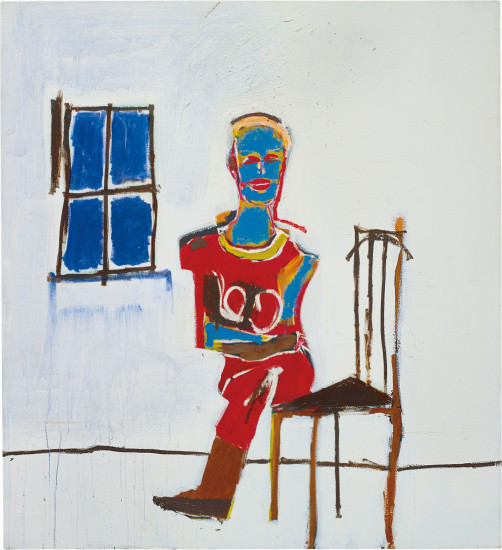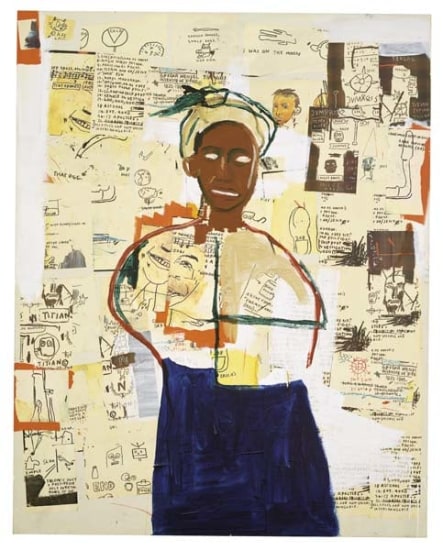Jean-Michel-Basquiat Self-Portrait 1982 colored crayon, black felt tip pen, and acrylic on Arches wove paper sheet: 29 7/8 x 22 1/4 in. (75.9 x 56.5 cm) Initialed “JMB” on the reverse. This work is accompanied by a certificate of authenticity issued by the Authentication Committee for the Estate of Jean-Michel-Basquiat.
Provenance Annina Nosei Gallery, New York Mr. Darius Glowacki, 1984 Michelle Rosenfeld Inc., Fine Arts, New Jersey, 1985 Mr. Joseph McHugh, 1985 Mr. Tim and Mrs. Janine Netsky Michelle Rosenfeld Inc., Fine Arts, New Jersey, 1989 Mr. and Mrs. Martin Rosenman, 1999 Marc Grossman, Brussels Private Collection Exhibited Roslyn Harbor, Nassau County Museum of Art, Miró-Dubuffet-Basquiat, March 13- May 23, 2010 Literature Nassau Museum of Art, Miró/DuBuffet/Basquiat, Roslyn Harbor, Nassau County Museum of Art, 2010, p.4 (illustrated) Catalogue Essay Comprised of colored crayon, black felt tip pen, and acrylic paint on Arches wove paper, the present lot, Self-Portrait, 1982, exemplifies the condensed and self-awareness that propelled the young Jean-Michel-Basquiat into the pantheon of visual artists and would posthumously reveal the magnitude of his contributions to contemporary art. This introspective representation of self-dissection conveys an unequivocal conviction that radiates off the sheet. Here, at the tender age of 22, Basquiat depicts himself as a powerful figure, his kinetic energy bursting with an aura of vibrant citrus colors; evidence that the radiant child was already negotiating with the praise and attention that was so readily thrust upon him. Working out of the basement of Annina Nosei’s gallery on Prince Street, this was a time of tremendous productivity for the young artist, creating large paintings on canvas and on board, as well as producing an unusually high volume of drawings. This remarkable output of physical, emotional, and intellectual energy is palpable in the present lot, a self-portrait that situates Basquiat in arguably the most artistically prolific period of his short life. An influential troubadour of the artist’s early career was Rene Richard, whose description of Basquiat’s work has proven resourceful to this day; “If Cy Twombly and Jean Dubuffet had a baby, and gave it up for adoption, it would be Jean-Michel-” Rene Ricard, “The Radiant Child,” Artforum, (December 1981), p. 43). Cause for comparison, the radical nature of Dubuffet’s work would come to typify the trope of rebellious artist, whose reactionary art would express a rejection of beauty and conformity, ultimately gaining respect and affluence within the art world. Of course,Twombly was of notable influence on Basquiat, who often affirmed his admiration for the Abstract Expressionist, however, one can clearly recognize an aesthetic connection between Dubuffet’s graffiti-like figures and the gritty intensity that surfaces in Jean-Michel-Basquiat’s draftsmanship. Boasting strong features, broad shoulders, a thick muscular torso and limbs, Basquiat’s ego emerges through Self-Portrait as amalgamation of ideals: the Vitruvian man, the athlete (Joe Louis), the lauded artist adorned with a crown of laurels. Drafting his body with a black felt tip pen, the artist takes deliberate measures to call attention to the articulation of his body; pin pointing his hands in relation to the rest of his joints– calculating his entire body in a gesture of encompassing creativity. These pin points are also supplemented by various symbols, a reoccurring theme throughout Basquiat’s oeuvre, which correspond to physical properties of mercury, and saltpeter. The use of symbolism underscores the artists’ deep interest in alchemy, the relationship between his intellectual and the physical action of the creative process, and its collision with various artistic mediums. Often referencing mask-like faces, here, the artist does not bare a specific facial expression. Instead, he appears poised, frozen in a moment of creative intensity, his crown simultaneously symbolizing his prominence as well as the physical and intellectual connection between mind and body. In Self-Portrait, 1982, Basquiat layers his draftsmanship with a palate of primary colors that evoke an elevated stature, an implicit sense of royalty. The concentration of his hues are intensified by their gestural
Jean-Michel-Basquiat Self-Portrait 1982 colored crayon, black felt tip pen, and acrylic on Arches wove paper sheet: 29 7/8 x 22 1/4 in. (75.9 x 56.5 cm) Initialed “JMB” on the reverse. This work is accompanied by a certificate of authenticity issued by the Authentication Committee for the Estate of Jean-Michel-Basquiat.
Provenance Annina Nosei Gallery, New York Mr. Darius Glowacki, 1984 Michelle Rosenfeld Inc., Fine Arts, New Jersey, 1985 Mr. Joseph McHugh, 1985 Mr. Tim and Mrs. Janine Netsky Michelle Rosenfeld Inc., Fine Arts, New Jersey, 1989 Mr. and Mrs. Martin Rosenman, 1999 Marc Grossman, Brussels Private Collection Exhibited Roslyn Harbor, Nassau County Museum of Art, Miró-Dubuffet-Basquiat, March 13- May 23, 2010 Literature Nassau Museum of Art, Miró/DuBuffet/Basquiat, Roslyn Harbor, Nassau County Museum of Art, 2010, p.4 (illustrated) Catalogue Essay Comprised of colored crayon, black felt tip pen, and acrylic paint on Arches wove paper, the present lot, Self-Portrait, 1982, exemplifies the condensed and self-awareness that propelled the young Jean-Michel-Basquiat into the pantheon of visual artists and would posthumously reveal the magnitude of his contributions to contemporary art. This introspective representation of self-dissection conveys an unequivocal conviction that radiates off the sheet. Here, at the tender age of 22, Basquiat depicts himself as a powerful figure, his kinetic energy bursting with an aura of vibrant citrus colors; evidence that the radiant child was already negotiating with the praise and attention that was so readily thrust upon him. Working out of the basement of Annina Nosei’s gallery on Prince Street, this was a time of tremendous productivity for the young artist, creating large paintings on canvas and on board, as well as producing an unusually high volume of drawings. This remarkable output of physical, emotional, and intellectual energy is palpable in the present lot, a self-portrait that situates Basquiat in arguably the most artistically prolific period of his short life. An influential troubadour of the artist’s early career was Rene Richard, whose description of Basquiat’s work has proven resourceful to this day; “If Cy Twombly and Jean Dubuffet had a baby, and gave it up for adoption, it would be Jean-Michel-” Rene Ricard, “The Radiant Child,” Artforum, (December 1981), p. 43). Cause for comparison, the radical nature of Dubuffet’s work would come to typify the trope of rebellious artist, whose reactionary art would express a rejection of beauty and conformity, ultimately gaining respect and affluence within the art world. Of course,Twombly was of notable influence on Basquiat, who often affirmed his admiration for the Abstract Expressionist, however, one can clearly recognize an aesthetic connection between Dubuffet’s graffiti-like figures and the gritty intensity that surfaces in Jean-Michel-Basquiat’s draftsmanship. Boasting strong features, broad shoulders, a thick muscular torso and limbs, Basquiat’s ego emerges through Self-Portrait as amalgamation of ideals: the Vitruvian man, the athlete (Joe Louis), the lauded artist adorned with a crown of laurels. Drafting his body with a black felt tip pen, the artist takes deliberate measures to call attention to the articulation of his body; pin pointing his hands in relation to the rest of his joints– calculating his entire body in a gesture of encompassing creativity. These pin points are also supplemented by various symbols, a reoccurring theme throughout Basquiat’s oeuvre, which correspond to physical properties of mercury, and saltpeter. The use of symbolism underscores the artists’ deep interest in alchemy, the relationship between his intellectual and the physical action of the creative process, and its collision with various artistic mediums. Often referencing mask-like faces, here, the artist does not bare a specific facial expression. Instead, he appears poised, frozen in a moment of creative intensity, his crown simultaneously symbolizing his prominence as well as the physical and intellectual connection between mind and body. In Self-Portrait, 1982, Basquiat layers his draftsmanship with a palate of primary colors that evoke an elevated stature, an implicit sense of royalty. The concentration of his hues are intensified by their gestural

.jpg)









Try LotSearch and its premium features for 7 days - without any costs!
Be notified automatically about new items in upcoming auctions.
Create an alert